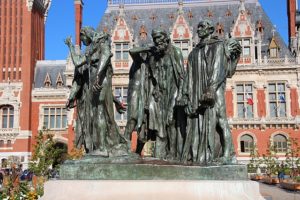In another incident of a major British museum messing up, the Glasgow Museums have recently admitted that it has misplaced its plaster copy of one of the most famous works by the French sculptor Auguste Rodin. Glasgow Life, which oversees and manages the public museums and galleries in Scotland’s largest city, has added the plaster copy of part of Rodin’s Les Bourgeois de Calais to its roster of 1,750 stolen and missing items. The work, showing one of the six figures portrayed in the original bronze, was displayed by the artist at the Glasgow International Exhibition in 1901. The Glasgow Museums purchased the work and last exhibited it during the Open Air exhibition in Kelvingrove Park between June and September 1949. The museum has said that the sculpture is “unlocated”.
The original sculpture, Les Bourgeois de Calais or The Burghers of Calais, is a bronze statue completed in 1889 by Auguste Rodin. The city of Calais, which sits on the English Channel just over twenty-five miles across the water from Dover, originally commissioned the sculpture in 1884. The work, consisting of six figures standing on a single base, commemorates an episode from the city’s history where a group of Calais’s notables surrendered themselves in exchange for the city being spared from looting and destruction. In 1346, about ten years into the Hundred Years’ War, King Edward III of England laid siege to Calais. After eleven months, the city was in near ruin, so Edward announced that he would leave Calais alone if six local leaders, or burghers, gave themselves up. According to French chroniclers, these men were Eustache de Saint Pierre, Jacques de Wissant, Pierre de Wissant, Jean de Fiennes, Andrieu d’Andres, and Jean d’Aire. King Edward ordered them to appear outside the city walls with nooses around their necks. The six burghers were convinced that the English would execute them should they turn themselves over, yet they complied with the king’s demands. According to the story, Edward’s wife, Queen Philippa, pleaded for their lives to be spared since it would be a bad omen for the child with whom she was pregnant. Rodin’s sculpture of the six men with nooses around their necks has become one of his best-known works. The men appear haggard in simple, ill-fitting sackcloth garments, the effects of the eleven-month siege. They also seem daunted, indicating that Rodin is capturing them when they surrendered to the English rather than when King Edward spared them. The original casting of the sculpture is in Calais, across the road from the city hall. French law dictates that a mold or cast created by Rodin can be used no more than twelve times. Apart from the original, three other castings were made during Rodin’s lifetime, which are now located in the Glyptotek in Copenhagen, the Musée Royale de Mariemont in Belgium, and the Victoria Tower Gardens right next to the Houses of Parliament in London. The other eight casts were created between 1925 and 1995 and are located at museums in Philadelphia, Paris, Basel, Washington, Tokyo, Pasadena, New York City, and Seoul.
According to the Comité Rodin, the Glasgow plaster statue shows one of the six burghers, Jean d’Aire. Jérôme Le Blay, the committee’s director, called the loss “regrettable” but understands that as a plaster work, it’s understandable that museum staff did not give it the care and attention afforded to comparable bronze works. Le Blay and the Comité Rodin estimate the work is worth about €3.5 million, or about $3.7 million.

